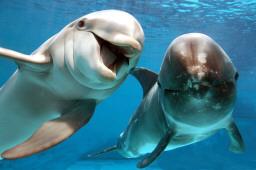A special airplane will be circling the skies off the northwestern Italian coast in coming days, as the country's first winter census of whales and dolphins gets under way.
The plane, launched by the Tethys Cetacean Monitoring Institute and financed by the environment ministry, will scan kilometres of sea in a large protected area.
The aim is to create a detailed picture of the types of cetaceans to be found in the area over winter, including their numbers and feeding grounds.
Although there are far fewer sightings of cetaceans in winter than in summer, researchers are optimistic about two species in particular, which have traditionally made regular appearances throughout the year.
The conspicuous markings of the striped dolphin, with its dark back and white or pink belly, make it easy to spot, particularly as it tends to move in large groups, while the fin whale is renowned for its size.
Usually clocking in at around 18 metres, the fin whale is the largest mammal in the Mediterranean and the second largest whale in the world.
Tethys Institute Vice-President Simone Panigada explained why researchers had taken the decision to carry out the census using a small plane.
''Boats are usually used to monitor cetaceans but planes are less dependent on weather conditions and will allow us to gather data quickly, going out just a few days when the weather and sea conditions are favourable and visibility good,'' he said.
The aircraft has been equipped with special 'bubble' windows, to allow researchers to observe the waters below. Its small size means it will make little noise, so as not to scare off the animals being counted.
''We will monitor the entire protected area, meaning the waters off the Ligurian and Tuscan coast and around the islands of Corsica and Sardinia,'' Panigada added.
The census is the latest in a series of Italian studies and initiatives aimed at safeguarding dolphins, whales and other marine life.
The area researchers will monitor is part of a much larger zone of water set aside as the Mediterranean's only marine mammal sanctuary in 2007.
It has long had a natural cetaceous population far greater than elsewhere in the Mediterranean, prompting Italy to formally propose the idea of a sanctuary in 1998.
The sanctuary, which stretches for more than 10 square kilometres in international waters, is a joint initiative between Italy, France and Monaco but is headquartered in Genoa.
As well as fishing and shipping restrictions, the governments concerned are also seeking to monitor and limit pollution levels through a series of public and private initiatives.









